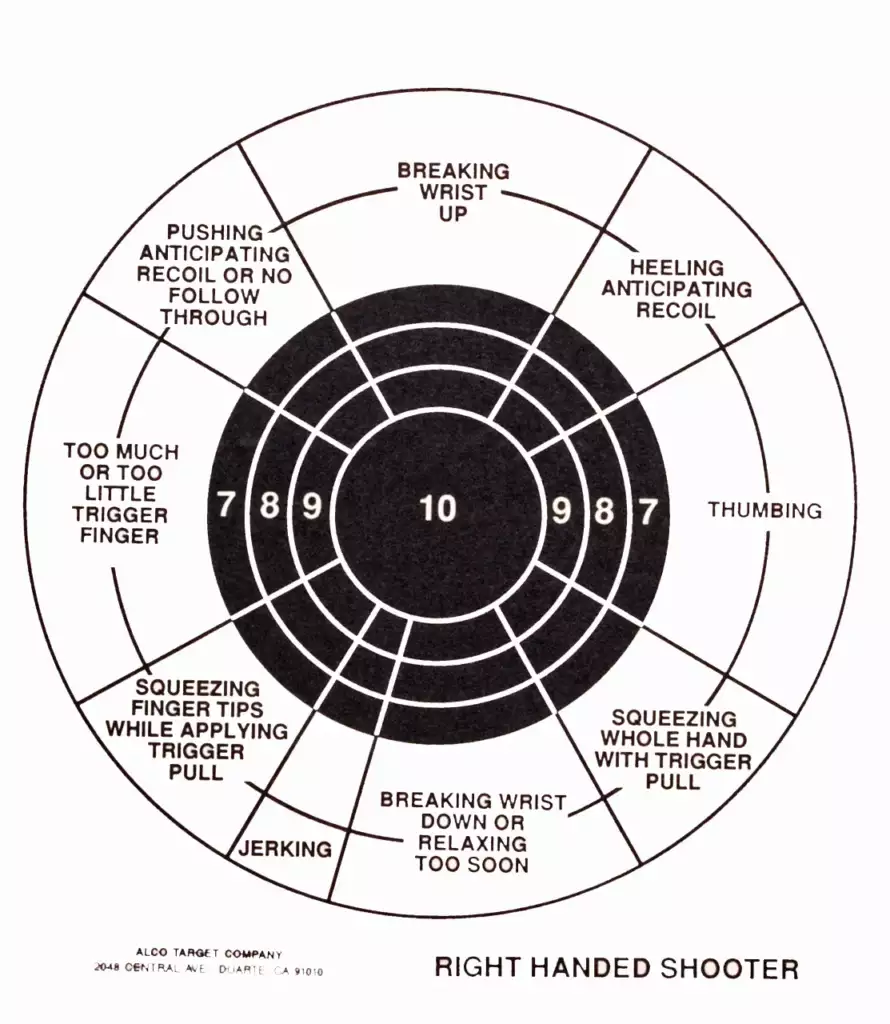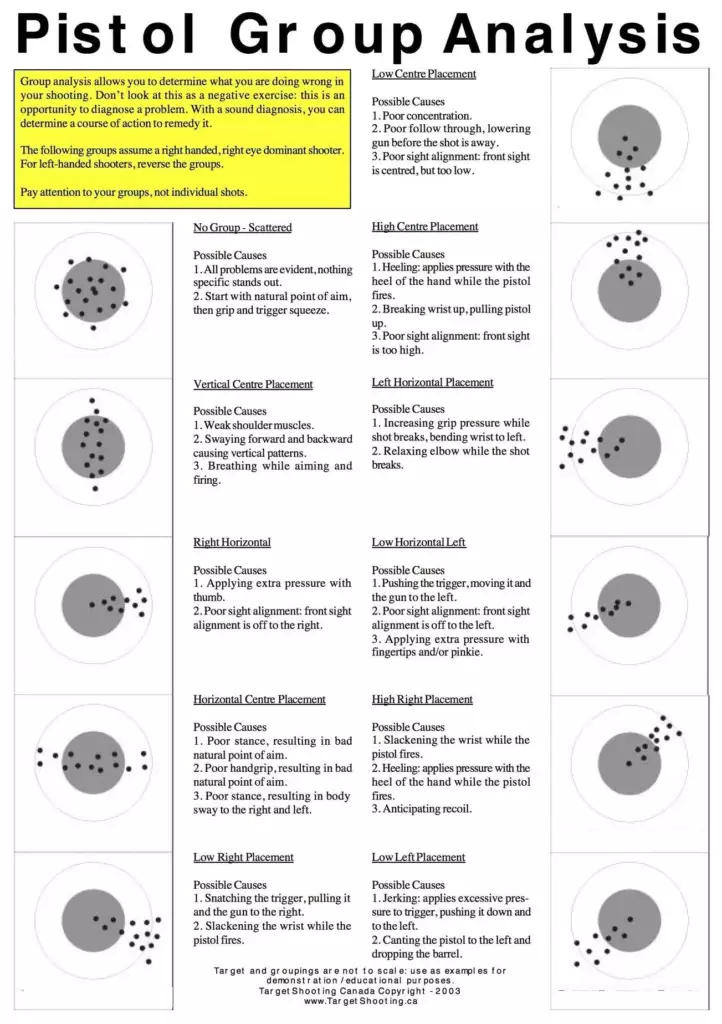If you’ve already been searching for shooting targets, you’ve probably noticed there’s a ton of options out there. Now, you might be wondering which which type you need exactly. In this guide, we’ll be talking about rifle and pistol targets for shooting – types, benefits, potential challenges, practice and safety tips, and more. Read on!
Paper Shooting Targets
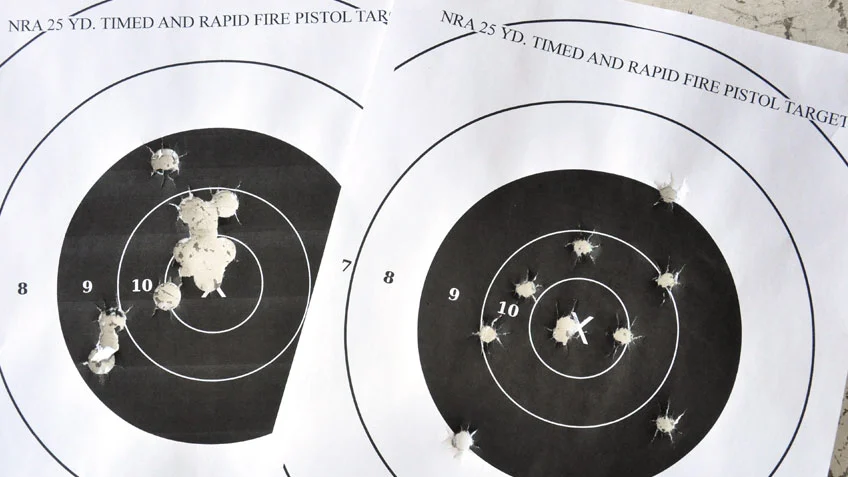
Paper targets are perfect for precision shooting because they give the best feedback on accuracy. Each shot creates a visible hole, allowing you to see exactly how well you’re shooting. Many paper targets also feature scoring zones to help identify areas for improvement. Whether you’re aiming to check shot groups, set your zero, or compete in shooting events, paper targets are the go-to choice. Plus, they are cheap, customizable, portable, and are allowed at indoor gun ranges.
Paper targets come in various shapes, sizes, and designs to suit different training scenarios. Bullseye targets are perfect for honing precision, while silhouette targets are excellent for defensive shooting practice. Specialty designs cater to more specific needs – for instance, zombie targets are simply for fun plinking, while turkey head targets are for shot pattern testing.
To make your start in the world of shooting sports predictable, you must keep in mind a few drawbacks paper shooting targets have. First off, they are expendable, meaning you’ll need to replace them often. Also, keeping paper targets still can be challenging. Indoor ranges don’t face this issue, but for outdoor shooting, you’ll need a sturdy paper target stand. Consider investing in a collapsible stand that easily fits in your vehicle. Alternatively, you can improvise with solutions like a cardboard box filled with rocks, a campaign yard sign, or a builder sign holder. Remember, avoid nailing paper targets to trees as it harms the trees and increases the risk of ricochets.
How to Choose a Paper Shooting Target
The rule of thumb is:
- For precision practice, choose smaller targets that require precise shot placement. This is especially important for long-range rifle shooting.
- If you’re practicing tactical or rapid shooting, larger targets at closer distances can help you develop fast and accurate shooting skills.
If you’re a pistol shooter, consider starting with NRA pistol targets. Here’s how these targets are used in competitions, but you can set them however you like:
- TQ-6 slow fire target and TQ-7 timed and rapid-fire target at 25 feet.
- B-2 slow fire target and B-3 timed and rapid-fire target at 50 feet.
- B-16 slow fire target and B-8 timed and rapid-fire target at 25 yards.
- B-6 slow fire target at 50 yards, and B-8 timed and rapid-fire target at 25 yards.
- B-4 target at 20 yards.
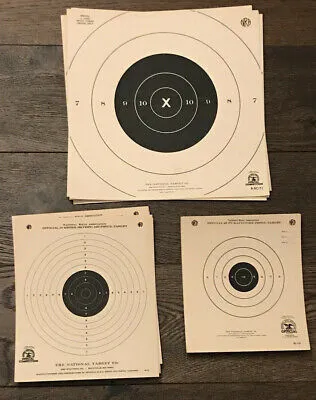
For defense shooting practice, opt for silhouette or x-ray shooting targets. The latter are especially helpful as they provide an overlay of human anatomy, which serves as a visual guide for effective shot placement at vital areas.
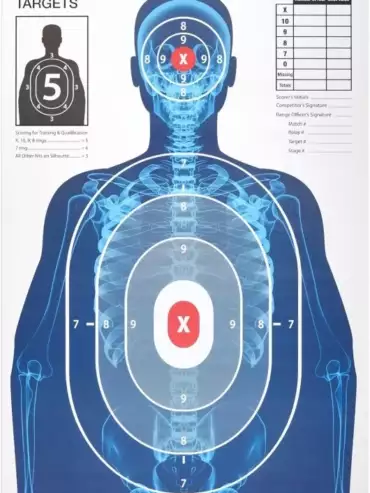
Also, consider IPSC/USPSA and IDPA action targets. These are made for practical pistol shooting competitions and will be great for tactical and dynamic shooting. Generally, these targets challenge shooters with varied shapes and scoring zones and help develop speed, accuracy, and decision-making skills.

If you’re looking for rifle shooting targets, you might want to check out Redfield targets or other grid targets made specifically for zeroing scopes and sights as well as long-range precision shooting.
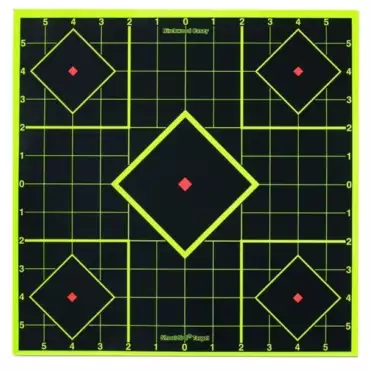
How to Read Shooting Target for Improvement
Your shot marks on the target can tell much more than just hit or miss. To truly gauge your progress and identify areas for improvement, it’s crucial to understand what hitting certain areas on the target means. By analyzing the patterns and locations of your shots, you can uncover common shooting errors and make necessary adjustments to your technique. This makes your practice sessions more purposeful and effective.
For beginners looking to train their shooting skills, diagnostic pie chart targets are a valuable tool. Made for both right- and left-handed shooters, these targets help identify common shooting mistakes:
- Pushing (anticipating recoil)
- Heeling (pushing with the heel of the hand)
- Jerking (aggressively pulling the trigger)
- Thumbing (applying too much pressure with the thumb)
- Pinkie pressure (applying too much pressure with the pinkie)
- Breaking the wrist up or down
- Drooping the head
- Tightening the grip while pulling the trigger
- Incorrect trigger finger placement
To improve shot control, focus on sight alignment, maintain your concentration, keep your head erect, and ensure a positive, rearward trigger release. Do not relax immediately after firing.
Analyzing shot patterns is the next step. There are charts available that can guide you in understanding your shot groups and making necessary adjustments for improvement.
Steel Shooting Targets
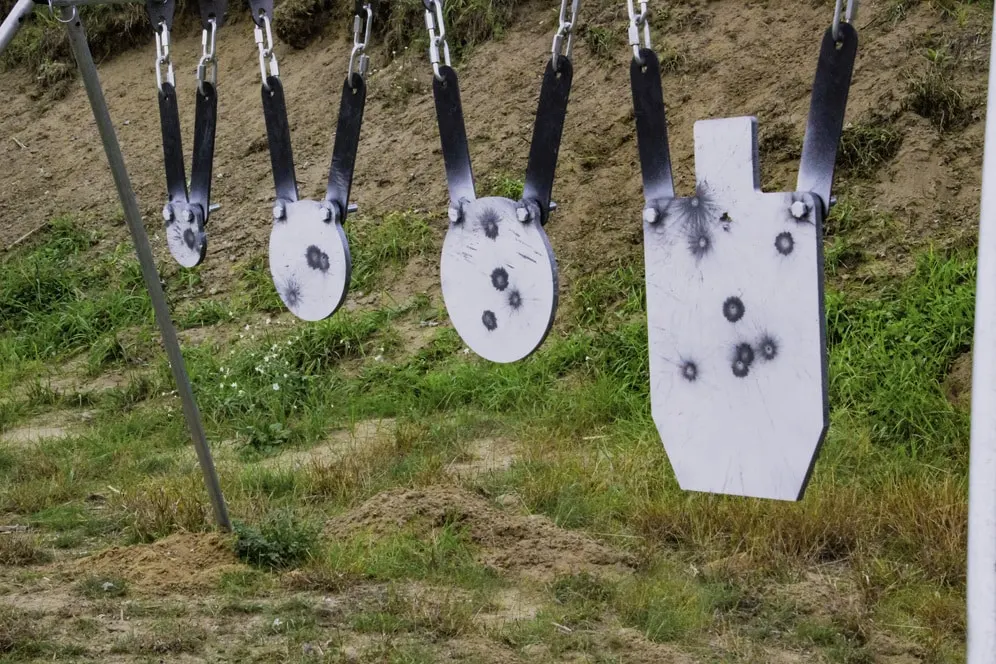
Steel targets provide immediate feedback with the audible “ping” sound when hit, making shooting more engaging and fun. The most popular types of steel targets include silhouettes and gongs. Gongs are perfect for training accurate shooting – better get several gongs in different sizes and transition from larger to smaller as your marksmanship improves. Silhouettes are great for mimicking real-life scenarios and are often used in competitive shooting and tactical training.
Steel targets offer several benefits. They give instant audible feedback, so you know right away if you hit the target. They are also very durable and reusable, not needing frequent replacement like paper targets. Often, a spray paint touch-up is all that’s needed to keep them in good condition.
Choosing the Right Size
The size of the steel target depends on several factors, like shooting distance, the weapon being used, and the shooter’s skill level. For rifle shooting at 100 yards, a 10″ steel target is a good choice as it’s large enough to consistently hit. For handgun shooting at closer distances, say 15 yards, a 10″ to 12″ target is ideal.
Are Steel Targets Safe?
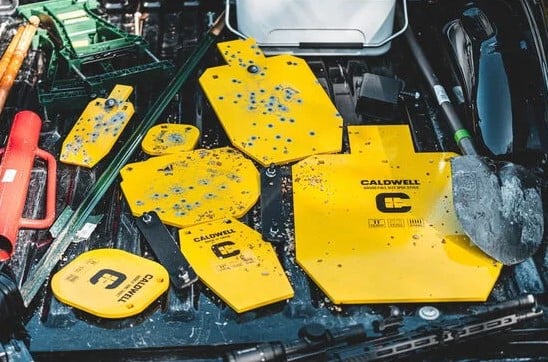
Though many worry about ricochets, they are rare with steel targets. If you follow specific guidelines, your steel target will simply cause the bullet to destroy on impact. Here are general guidelines for proper steel target usage:
- Use only AR500 or AR550 certified targets. AR500 3/8″ targets are suitable for pistols, while 1/2″ AR500 and 1/2″ AR550 targets are better for rifles.
- Angle the target downward.
- Maintain a safe distance: 25 yards for pistol shooters, 100 yards for rifle shooters, and 30 yards for shotgunners.
- Use the correct ammo, usually FMJ and softer bullets. No armor-piercing ammo.
- Avoid using damaged or overly worn targets.
- Always follow the manufacturer’s guidelines.
Reactive Targets
Reactive targets provide visual and kinetic feedback, making them highly engaging. When hit, these targets move, pop up, or change position, helping shooters work on dynamic shooting drills. Some popular reactive targets include dueling trees, torsos, Texas stars, plate racks, and poppers.
Reactive targets that reset are ideal for shooting practice, saving you time and effort. For instance, poppers reset automatically, while dueling trees can be reset by simply shooting the paddle again.
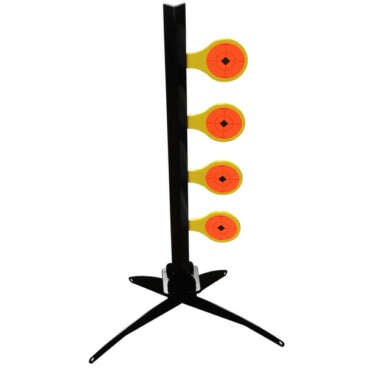
Dueling trees are especially fun for simulating gunfights between two shooters. You can see who can clear their side of the tree faster, adding a competitive edge to your shooting practice.
You don’t always need to purchase reactive targets. Get creative and make your own using everyday items. Fill colored balloons, soda cans, bags of flour, milk jugs with water, or even clays for shotgunning set stationary to create reactive targets.
Choosing the Right Target for Training Goals
Skill Level
If you’re new to shooting, start with larger targets like steel gongs at closer distances. Paper bullseye targets, such as B-8 set at a distance shorter than the intended 25 yards, can also help you focus on basic accuracy. Try using diagnostic paper targets to understand and fix common shooting mistakes. As you improve, opt for smaller targets or move targets farther away.
Training Objectives
Think about what you want to achieve. For precision shooting, use paper bullseyes or grid targets to work on pinpoint accuracy. If you’re working on speed and reaction time, consider larger silhouette targets at closer distances. For defensive drills, steel silhouettes or human-shaped targets are ideal.
Budget
Paper targets are affordable and great for short-term use. Steel targets are more of an investment but are durable and reusable. If you’re on a budget, a mix of paper and reactive targets can give you variety without breaking the bank.
FAQs
Ideal targets for rifle shooting depend on your specific training objectives, distance, and the type of rifle you are using. Grid targets are perfect for long-range shooting and sighting in your rifle. These targets allow for precise adjustments and provide clear visual feedback over long distances. Bullseye targets are excellent for mid- and short-range precision shooting. Bullseye targets help you practice accuracy and consistency. Steel targets are ideal for more action-oriented shooting. Steel targets provide immediate audible feedback when hit, allowing for rapid follow-up shots. AR500 or AR550 steel targets are recommended for durability and can handle repeated impacts without significant wear.
Self-healing targets can take multiple hits while staying intact. Made from tough materials like high-density polymers, they allow bullets to go through without much damage. When a bullet hits, the material seals the hole, “healing” itself. This means they can last for thousands of shots before needing to be replaced.
First off, you can use frames from old campaign and builder signs and attach paper targets with clips or tape. Another option is to use wood or PVC pipes to create a rectangular frame. Ensure the base is wide enough for stability, especially in wind. As a quick temporary solution, fill a cardboard box with sand or rocks for weight, then attach your target with tape or staples.
Consider these manufacturers:
- Birchwood Casey: Known for their Shoot-N-C targets, which provide instant feedback with a visible burst of color around the bullet hole.
- Champion Traps & Targets: Offers a wide range of paper and reactive targets, including their popular VisiColor targets.
- Caldwell: Specializes in steel targets and stands, known for their durability and ease of use.
- Action Target: Provides professional-grade steel targets often used in law enforcement and military training.

